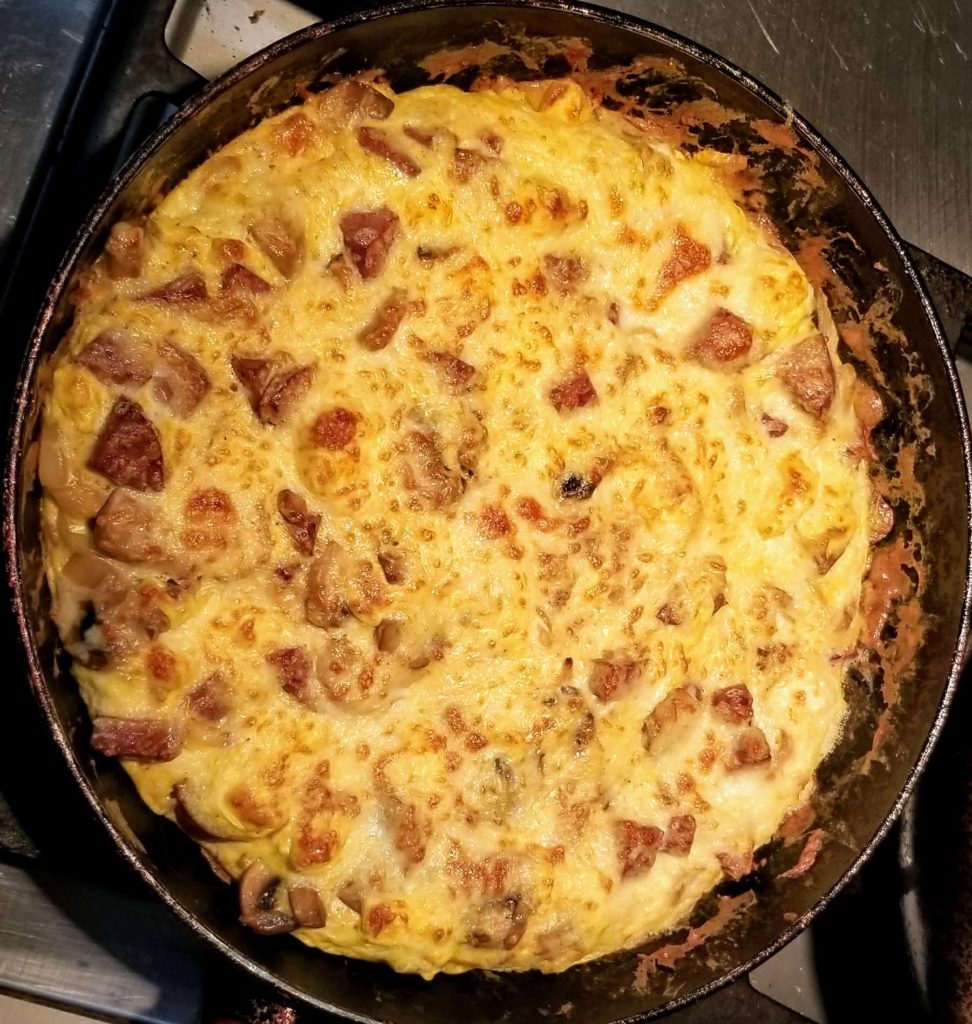Frittata!
You NEED to add this to your culinary repertoire. What’s a frittata? Well, you can think of it as “scrambled eggs with stuff” or (if you must) a crustless quiche. (Since I can’t eat wheat, the regular kind is probably out of the question for me, anyway.)
It’s a great way of putting a bunch of extra eggs to good use, as well as using leftovers. Anything you can think of that would go well with eggs will (probably) do well in a frittata. (You’ll probably want to avoid pineapple or papaya or anything else that messes with egg proteins.)
That said, you will need to keep in mind that while cooking will get it hot enough to melt shredded cheese, it will not cook meat, or soften vegetables (and certainly won’t brown them). You’ll need to do this in advance, even if right before adding your scrambled eggs. This is why it’s such a good taker of ‘tovers.
You’ll need a 10-12 inch skillet: well-seasoned cast iron (meaning the egg won’t stick to it) will work wonderfully. I actually use a garden-variety non-stick. Word of caution: you will be finishing this in the oven, under the broiler. My non-stick actually has plastic handles, so yes, I have to be VERY careful and attentive. (And non-stick coatings aren’t super fond of being ovened.) If using cast iron, just remember the handle will get very hot.
You’ll need 8-12 eggs, depending on how big a frittata you’re making. Twelve-inch skillet? Probably 10-12. As a rule, you don’t want to go much beyond 1:1 in terms of volume of filling and beaten egg, or else you won’t have enough egg to hold it together, so let that be your guide in terms of how many eggs (or how much filling).
Some thoughts on opening eggs: crack them one by one into a custard cup, mug, or small bowl, confirm the egg is good (and doesn’t have shells in it), then add each one to your bowl in which you’ll scramble them. You don’t want to add a bad egg into eleven good ones. This extra step prevents that.
Lightly scramble with a fork until, um, scrambled. You don’t have to get super carried away with beating them. Some people add a bit of milk or cream (I usually don’t).
Contemplate your filling. Shredded/crumbled cheese and things like chopped spinach and herbs? I mix them right into the beaten eggs. Veggies like broccoli that are tough when raw probably want a parcook. (Leftover broccoli works wonders here.)
If you need to cook any meat: heat your skillet and add some fat (of your choice). Fatty meats like sausage may want excessive fat drained after cooking. Veggies needing cooking/browning like mushrooms or onions? Go ahead and do so.

Preheat your oven’s broiler, and let it heat your oven a bit. The oven is principally to finish cooking the top part (and brown it a bit), but a warm oven will help ensure it’s cooked throughout.
Okay, here we go: medium-hot pan (with filling if applicable, with a bit of oil if not), medium-high heat, evenly pour atop your beaten eggs (and whatever). Shake your pan a bit to settle everything, then – and this is the trick – with a spatula (I use wood or bamboo) you’re going to GENTLY stir a bit to begin cooking the eggs and forming scrambled egg curds. You’re ONLY going to do this for a few seconds, until curds just begin forming. Then turn the heat down to low, shake the pan and smooth over roughness a bit with the spatula, then press it down the sides to help form the cooking eggs and stuff into a disk (and get it to loosen from the sides of the pan). Go round and round.
Once you see it’s pulling away – and your best guess is all but the top is set – we’ll move it to the oven. The spatula chore shouldn’t take long at all – maybe a minute, maybe even less. Under the broiler with it… and PAY ATTENTION. This goes quick. Usually under a minute, then I like to turn it 90 degrees or so. Do this just until the top is set with just a bit of browning. Don’t overdo it.
Take it out, and once again do the spatula down the sides dance to help loosen it from the pan.

After letting it rest a bit, put a plate atop it, and (carefully and with potholders or clean/dry side towels) invert so the frittata comes out of the pan and onto the plate. Then place your very pretty serving plate over top that, and invert again so the browned side is up.

I like to serve by cutting into wedges:

The great thing about the frittata: any leftovers can go in the fridge for another meal: lunches or dinner or even breakfast, so you need not fret about using so many eggs. Reheat in the microwave or serve cold. This is great for a single individual or busy couple.